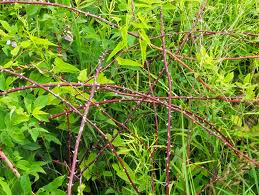 |
| Vulnerable robin's nest in an oak tree. by Grandma Pearl |
Nature can be harsh, especially when it comes to wild babies. Newly laid eggs, nestlings and fledglings are particularly at risk because they are favorites of predators like other birds, raccoons, squirrels, feral cats, etc. But you can give them a safer environment and a better chance at survival using the following easy solutions.
*Remember not to use toxic chemicals in your environment. They harm all life, including humans; plus they find their way into our water sources. If you attract birds, you will not need poisons to be rid of insect pests. But if you still feel you need to control the bug population, choose organic and non-toxic options.
1. Make a bird nesting basket to camouflage and thus hide the baby birds. Click here for the 5 easy steps.
 |
| Make a bird nesting basket using my 5 easy steps. by Grandma Pearl |
2. Plant a briar patch. You'd be surprised how many birds are attracted to thorny berry plants. In addition to being a great food source, the sharp tangles discourage even the most persistent predator. It doesn't have to be a large patch to make a huge difference. Find out more here.
 |
| Briar patches don't need to be large to help birds. by Grandma Pearl |
3. Climbing Rose Bushes offer another type of shelter with built-in predator resistance. Not only that, but these bushes are home to bugs relished by backyard birds. Cardinals are especially fond of nesting in rose bushes. Choose rose varieties that produce rose hips, and you will also be feeding birds all winter long. Rose hips provide much needed nutrients not otherwise available during the wintertime. Create Safe Bird Habitats With Climbing Roses
 |
| Robin Hood Climbing Rose creates a dense tangle of thorny branches just right for hiding bird nests and baby birds by Grandma Pearl |
4. Dense vines make excellent nesting sites for birds. Tangled vines are easily accessible by birds, but are a natural deterrent for the predators that would make easy pickins' out of birds' eggs and bird babies. See which vines work the best here.
 |
| Wild grape vines will quickly grow to shelter bird nests in the future. by Grandma Pearl |
5. Mount your birds houses right on your own house. Birds like hawks don't like to venture too close to human habitats. Other predators find it hard to reach the baby birds when the nest box is installed on a high vertical surface. Install them on the non-windy side, and under an overhang if possible. See how I used a climbing hydrangea vine to surround one of my bird houses here.
 |
| bird house mounted on my house in my hydrangea vine by Grandma Pearl |
Grandma Pearl
2 comments:
These are such wonderful tips, Connie. You provide an education with each post or article you write. I would love to walk your property with you some day.
Thanks Shauna! You are hereby invited to take a tour of my 'back 40', which means about 40 feet! But it is packed with lots of stuff the birds love. And then there's the 3 acres of woods that always hold a fascinating variety of flora and fauna. We would have a blast!
Post a Comment